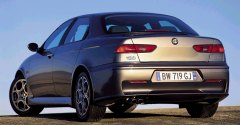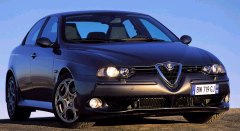 Born
to rival with BMW's mighty 3 series, Alfa knows how good it had to make
the 156 be. Since Alfa Romeo was taken by Fiat in the 70's, it faced
year
after year tough times and still failed to find its own way for
survival.
It tried to rely on its "good old" tradition like boxer engine,
twin-spark
plugs, sporty V6 and rear transaxle gearbox..... but all failed to make
money. Then it tried another extreme to base its 155 on Fiat mainstream
Tipo platform, again fail to attract customers. Obviously, the product
planners should responsible for all these failure. They should have
known
that Alfa has to make good use of its historical sporty image to rival
the like of BMW and Audi, instead of compete directly with those giant
bread-and-butter car makers. Alfa cars should be sporty, should be
distinctive,
should be exciting. Born
to rival with BMW's mighty 3 series, Alfa knows how good it had to make
the 156 be. Since Alfa Romeo was taken by Fiat in the 70's, it faced
year
after year tough times and still failed to find its own way for
survival.
It tried to rely on its "good old" tradition like boxer engine,
twin-spark
plugs, sporty V6 and rear transaxle gearbox..... but all failed to make
money. Then it tried another extreme to base its 155 on Fiat mainstream
Tipo platform, again fail to attract customers. Obviously, the product
planners should responsible for all these failure. They should have
known
that Alfa has to make good use of its historical sporty image to rival
the like of BMW and Audi, instead of compete directly with those giant
bread-and-butter car makers. Alfa cars should be sporty, should be
distinctive,
should be exciting.
Anyway, finally it realized this and created the 156. Although somewhat it is derived from the Tipo platform, I would advise you better to see it as a completely new car. While the Tipo employed all struts / trailing arm suspensions, 156 has a new double wishbones front suspension. It is designed intentionally to provide BMW-level body control. The rear still rides on MacPherson struts, but rigider body and the application of sub-frames enhance the handling while absorb more noise and vibration. On road, the first thing to impress is the steering - 2.5 turns lock to lock provides ultra-quick response, and it is precise as well as communicative. 156 has the inherent understeer that appears on most front-wheel drive cars, but oversteer on throttle is also easily allowed, something a great driver's car shouldn't miss. Surprisingly, the ride is very supple compare with 155 and GTV, thus introduce noticeably body roll. However, the handling ability is not affected. When comes to the engine, no one will doubt Alfa. The marvellous twin-spark 16v series include 1.6 (120hp), 1.8 (144hp) and 2.0 (155hp). Alfa fans should be familiar with them, although they had been added with variable length induction manifold. Best of all is the new 24 valves 2.5 litres V6 - an engine that I used to think that GTV deserves. It is said to be updated from the sohc 2.5 which started life as early as the GTV6 coupe of 1979, now with new 24 valves head, twin cam and revised intake and exhaust. 190hp and 164lbft should please everyone. Note the peak torque appears at 5,000rpm, I guess this could be one of the sportiest sedan V6s in the world. Not only powerful, it generates beautiful noise. To further enhance the sporty character, Alfa also prepared a 6 speed manual for the 2.5V6, while a Ferrari-made F355 F1-like semi-auto gearbox is also developing. All these prove that Alfa is not joking. It is really serious to share the success with BMW. Inside the cabin,
156 provided
more room than BMW 3 series (note : the previous one) and Audi A4 but
less
than 155. Twin sporty dials in front of the nice-looking steering wheel
accompany with the central console-mounted circular gauges make the
cabin
looks radical and sporty. Furthermore, the best news is : Alfa finally
changed its Italian-style driving position to suit everybody else's
ergonomics.
Now its driving position becomes a comfortable place.
|
| The above report was last updated in 1998. All Rights Reserved. |
 This
created the 156 Selespeed. Like the F355 F1's system, the Selespeed is
a hydraulic actuator added to the normal manual gearbox and
incorporates
clever electronics. Instead of six-speed, the Alfa unit has 5 ratio
like
its conventional sisters. The operation is 90% the same as the
Ferrari's,
only shift smoother and slower. Gear shift is actuated by the two
buttons
located on the steering wheel (Ferrari use 2 pedals at the steering
column).
After pressing the button, the Magneti Marelli fuel injection and
electronic
throttle control will reduce the engine output, then actuate the clutch
and then change gears by fast-acting hydraulic actuators. After that,
clutch
engages again and the engine resume power. The whole process normally
takes
1 to 1.5 seconds, but it could be reduced to 0.7 sec when it is running
in "Sport" mode. However, shift quality in Sport mode is not as good as
normal mode.
This
created the 156 Selespeed. Like the F355 F1's system, the Selespeed is
a hydraulic actuator added to the normal manual gearbox and
incorporates
clever electronics. Instead of six-speed, the Alfa unit has 5 ratio
like
its conventional sisters. The operation is 90% the same as the
Ferrari's,
only shift smoother and slower. Gear shift is actuated by the two
buttons
located on the steering wheel (Ferrari use 2 pedals at the steering
column).
After pressing the button, the Magneti Marelli fuel injection and
electronic
throttle control will reduce the engine output, then actuate the clutch
and then change gears by fast-acting hydraulic actuators. After that,
clutch
engages again and the engine resume power. The whole process normally
takes
1 to 1.5 seconds, but it could be reduced to 0.7 sec when it is running
in "Sport" mode. However, shift quality in Sport mode is not as good as
normal mode.  Strangely,
automotive theories seem do not apply to Alfa Romeo 156 GTA. Putting
250
horsepower over the front wheels, having more weight at the nose than
the
existing 156 2.5 V6, theories tell us it must have serious handling
problems.
No, the engineers at Alfa Romeo worked out a miracle here: this is the
front-wheel-drive version of BMW M3 ! in some areas, especially driver
involvement and emotional character, it even surpasses the more
expensive
Munich rival.
Strangely,
automotive theories seem do not apply to Alfa Romeo 156 GTA. Putting
250
horsepower over the front wheels, having more weight at the nose than
the
existing 156 2.5 V6, theories tell us it must have serious handling
problems.
No, the engineers at Alfa Romeo worked out a miracle here: this is the
front-wheel-drive version of BMW M3 ! in some areas, especially driver
involvement and emotional character, it even surpasses the more
expensive
Munich rival.
 Fire
the engine, the cabin is immediately enhanced with another dimension
apart
from x, y, z and time, that is, sound. Now we know why Alfa Romeo need
not to seal its engine with plastic cover: with such a charismatic
engine
note, who will ask for sound insulation ? at town speed, the large V6
is
already very tractable, but its true color will only be revealed after
3000rpm, when its roar become increasingly urgent as rev rise. There is
no M3-like explosive power delivery, but power and torque increase
linearly
and it will rev cleanly towards redline. Because of such a good manner,
drivers will be encouraged to squeeze power out of high rev. Working
with
a slick 6-speed gearbox this is a great pleasure. (Selespeed is
optional.
Although smoothness and responsiveness have been improved, it is still
no match for a real manual)
Fire
the engine, the cabin is immediately enhanced with another dimension
apart
from x, y, z and time, that is, sound. Now we know why Alfa Romeo need
not to seal its engine with plastic cover: with such a charismatic
engine
note, who will ask for sound insulation ? at town speed, the large V6
is
already very tractable, but its true color will only be revealed after
3000rpm, when its roar become increasingly urgent as rev rise. There is
no M3-like explosive power delivery, but power and torque increase
linearly
and it will rev cleanly towards redline. Because of such a good manner,
drivers will be encouraged to squeeze power out of high rev. Working
with
a slick 6-speed gearbox this is a great pleasure. (Selespeed is
optional.
Although smoothness and responsiveness have been improved, it is still
no match for a real manual)  The
GTA is extremely entertaining to drive. It encourages its driver to
attack
twisty roads just for fun. Unlike many modern performance cars, it is
throttle-steerable.
Lift off throttle mid-corner, it will display a manageable oversteer to
tighten its line. This make it feeling nimbler than any German sports
sedans,
M3 included. How did Alfa do that ? I observe that the rear tyres of
Alfa
is 30mm narrower than the BMW, the whole car is 160kg lighter and
wheelbase
is 135mm shorter.
The
GTA is extremely entertaining to drive. It encourages its driver to
attack
twisty roads just for fun. Unlike many modern performance cars, it is
throttle-steerable.
Lift off throttle mid-corner, it will display a manageable oversteer to
tighten its line. This make it feeling nimbler than any German sports
sedans,
M3 included. How did Alfa do that ? I observe that the rear tyres of
Alfa
is 30mm narrower than the BMW, the whole car is 160kg lighter and
wheelbase
is 135mm shorter.